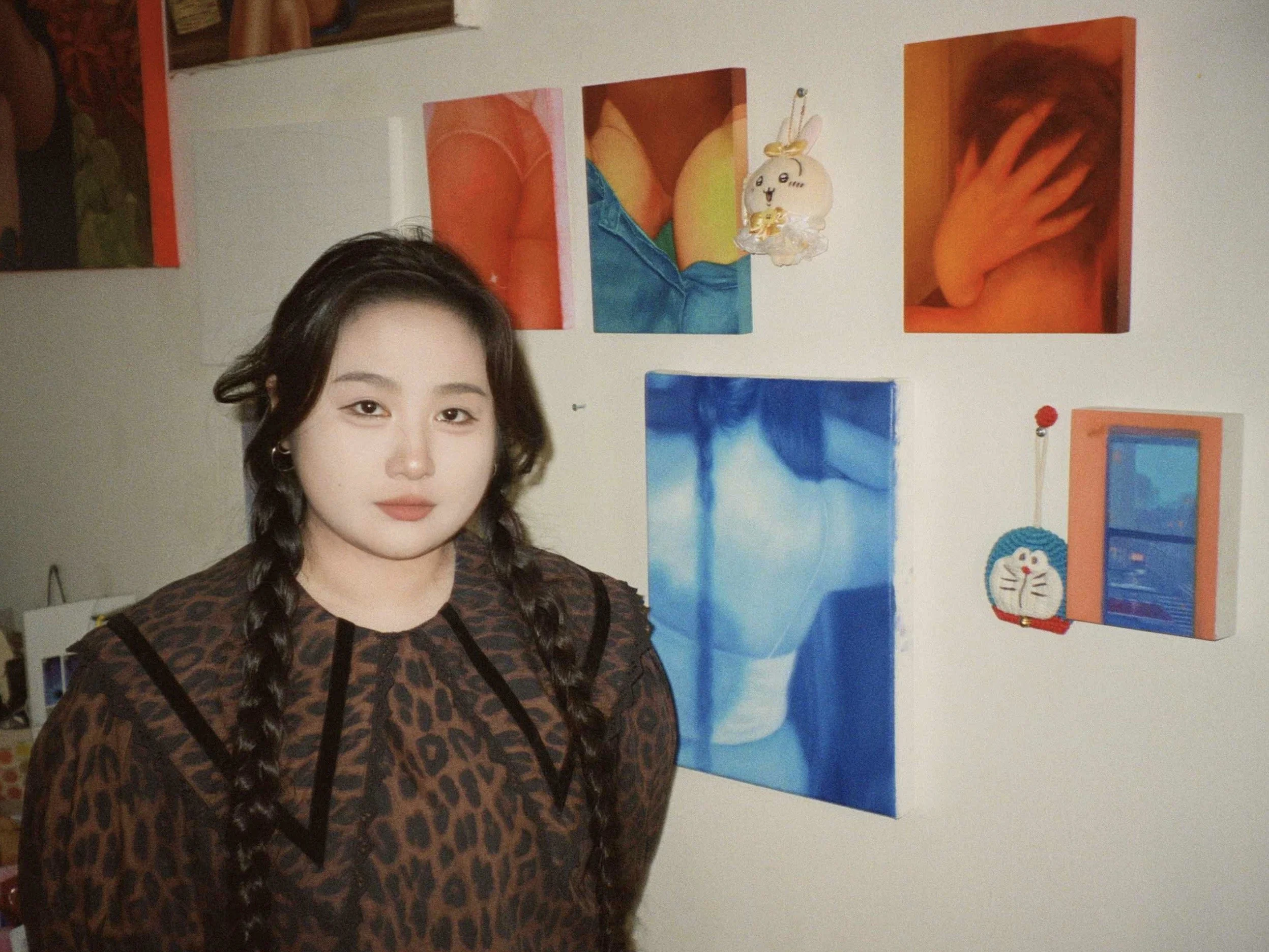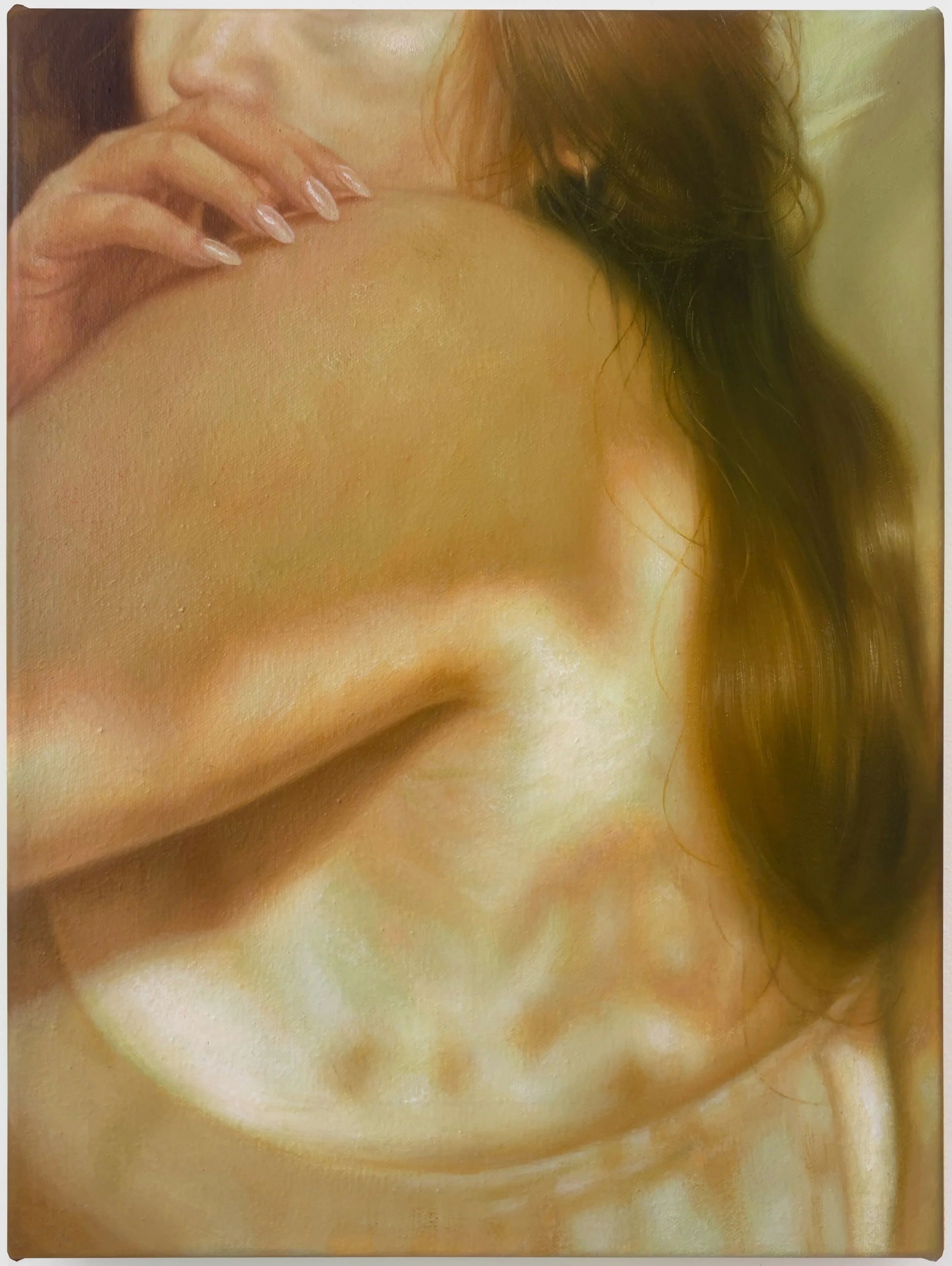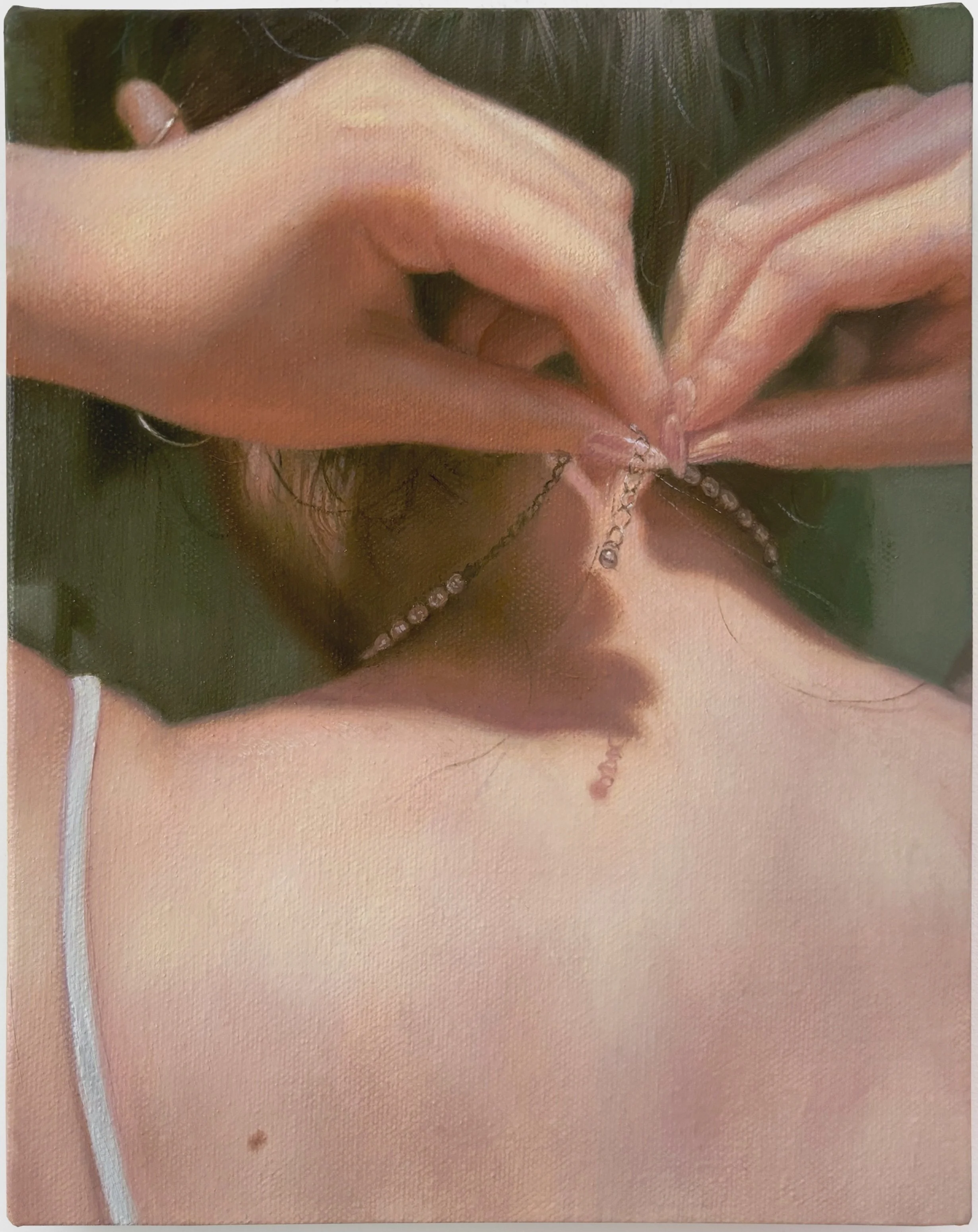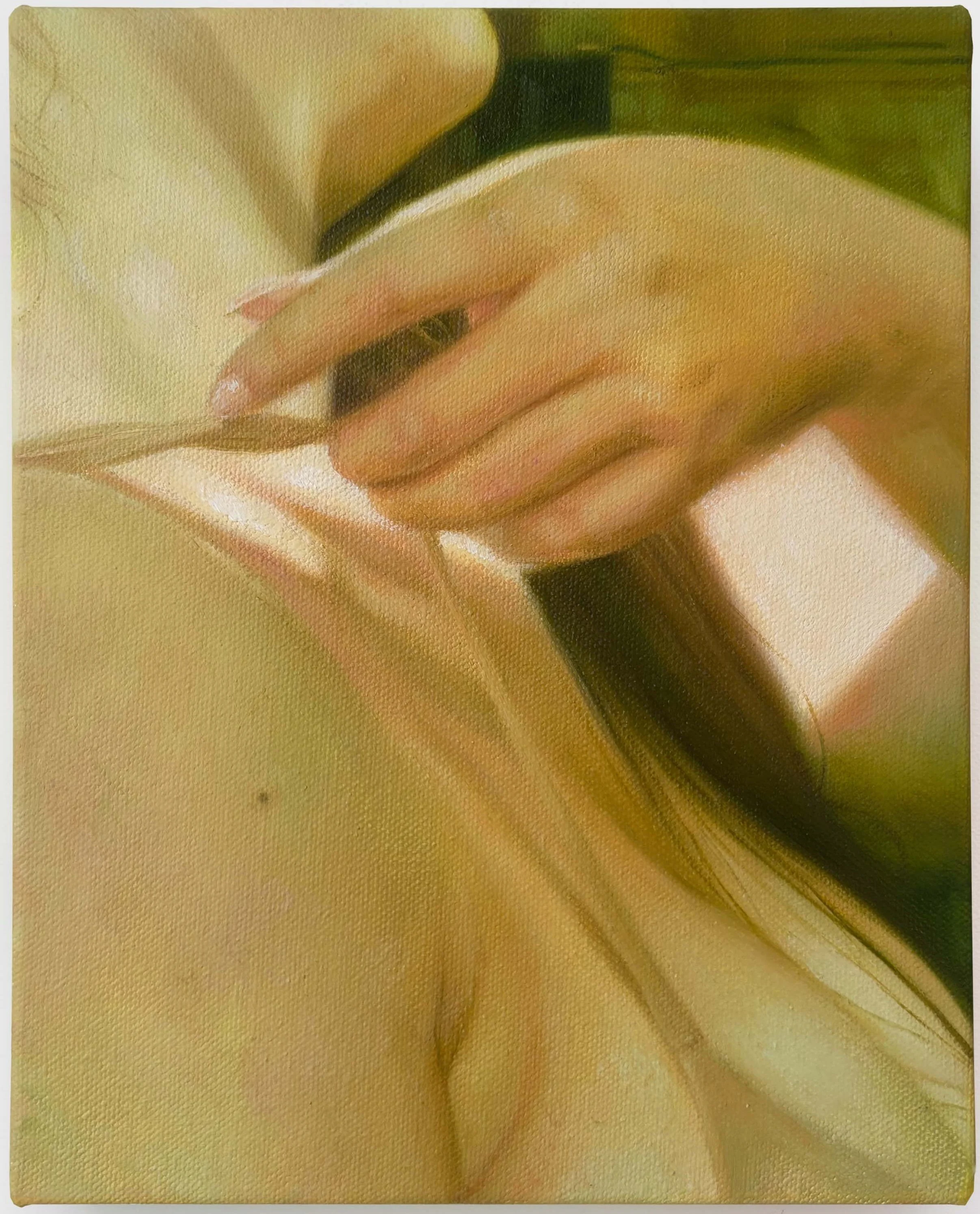Jesse Zuo talks to Phillip Edward Spradley
Portrait of Jeese Zuo. Courtesy of the artist.
Jesse Zuo’s paintings operate at the intersection of intimacy and estrangement, offering viewers a lens into the quiet rituals of women in private, interior spaces. Subjects braid their hair, adjust garments, paint their nails, or recline with a glass in hand, are depicted in moments of self-possession that resist spectacle. These figures do not perform for an outside gaze but instead embody the intimacy of leisure, care, and personal ritual. In focusing on such small acts, Zuo transforms the everyday into a subject of profound aesthetic and psychological resonance.
Central to her painting is the striking use of color. Zuo often saturates her canvases in bold hues—acidic greens, glowing ambers, smoldering crimsons—that heighten the emotional tenor of the scenes while dislocating them from conventional realism. These chromatic fields produce an atmosphere that feels both corporeal and spectral, collapsing the distance between the tactile materiality of flesh and the immateriality of memory or dream. Color in her earlier works often acted as a filter through which the viewer perceived the body, underscoring how perception itself is mediated and unstable.
In her more recent practice, however, Zuo’s approach has evolved. Rather than consciously working with specific color palettes from the outset, her attention has shifted toward a more intuitive engagement with light and shadow. This change reflects a deeper attunement to the transient qualities of illumination—how it moves across surfaces, obscures or reveals form, and evokes mood. The result is a subtle yet powerful transformation in her work: color becomes less a dominant strategy and more a consequence of light itself, further complicating the boundary between what is seen, felt, and remembered.
Zuo’s compositions frequently isolate portions of the body, in doing so, she fragments and reframes the figure, emphasizing gesture as a language of both presence and selfhood. The act of painting becomes less about narrating a complete figure and more about lingering on the significance of partial views, where meaning is embedded in touch, texture, and motion. These gestures, mundane in daily life, are elevated to painterly subjects that speak to the rhythms of embodiment and the subtle poetry of interior existence.
Her choice of interior settings deepens the sense of intimacy in her work. Beds, couches, and dimly lit domestic corners become stages for private acts of reflection, care, or repose. These interiors, however, are less backdrops than active participants in the narrative—spaces of enclosure that heighten the sensorial charge of color, light/shadow, and form. The containment of these environments echoes the containment of the vessel-like body, situating the figure within a larger meditation on boundaries, permeability, and interiority itself.
Zuo’s chromatic strategies, paired with depictions of women in moments of quiet leisure, engage broader questions of representation, agency, and perception. Rather than monumentalizing the body, she anchors it in everyday gestures, filtered through color fields that blur the line between realism and dream.
In recent works, this approach has shifted subtly. Some viewers see a move toward more “real” colors; others view it as a continuation of her palette. For Zuo, the focus is less on theory and more on intuition—painting what feels right. This instinctive process mirrors the fluid nature of perception itself: subjective, shifting, and deeply felt.
Zuo received both her BFA and MFA in Painting from the School of Visual Arts in New York. Her work has been exhibited at LATITUDE Gallery; New York, Sobering Galerie; Paris, Abigail Ogilvy Gallery; Los Angeles, Steven Zevitas Gallery; Boston, and V1 Gallery and Eighteen Gallery in Copenhagen.
Zuo will be participating in a dual exhibition, ‘Focus Tension,’ at Plato Gallery in New York on November 20, 2025.
Dawn, 2025. Oil on canvas, 16 x 12 in, Courtesy of the artist.
Phillip Edward Spradley: Your work situates itself within a lineage of figurative painters addressing intimacy and domesticity. What compels you to return to these private scenes?
Jesse Zuo: I’ve always been drawn to the subtle moments that often go unnoticed—the small, mundane gestures that make up most of our daily lives. There is something comforting and grounding about these moments. Painting these scenes allows me to slow down and focus on details that might otherwise be overlooked: the way light falls on skin, how a body moves when relaxed, and the feeling of being present in your own space.
Painting for me is a way to preserve these fleeting moments of intimacy and solitude. They may not be grand or dramatic, but they carry an honesty that feels deeply human to me. In many ways, returning to these private scenes helps me ground myself, allowing me to find stillness and familiarity amid the constant changes happening around me.
Daze, 2025. Oil on canvas, 16 × 12 in, Courtesy of the artist.
Your chromatic palette plays a strong role in your work, and oscillates between restraint and saturation. How do you see color operating as both material and psychological agent in your practice?
It has always felt intuitive to me when it comes to figuring out what colors to use for each piece; it could be swung by the weather, seasons changing, how I felt at the moment, etc. For example, bright yellows always feel like how skin would feel to touch on a hot sunny day when you feel a bit sweaty but only to a degree that you smells just fine; saturated green or cyan to me feels uncomfortable, they have this chemical-like glow that it almost seem suffocating; flush red reminds me of when your skin’s rubbed too much now it burns and is hurt to touch. Recently, I’ve been obsessed with portraying these moments of perhaps a nice and peaceful day, when sunlight lands on your skin, where it feels warm and fuzzy. At the end of the day, I hope that while the colors used convey these feelings of mine, they could somewhat translate through the paintings to the audience as well.
Slumber, 2025. Oil on canvas, 10 × 8 in, Courtesy of the artist.
Cropping and fragmentation are central to your compositions. What possibilities does the partial figure open up that a fully rendered figure does not?
I love when a piece of art feels intimate, as if you are invited into someone’s personal space. It’s not a feeling of intruding; rather, it’s like you’ve gently knocked on their door and been welcomed inside. The figures in paintings are naturally comfortable, and they continue with their day while you quietly observe.
I believe close-up cropping makes this sense of intimacy more accessible. Additionally, I appreciate that people tend to lean in when viewing small, highly detailed works. This invites the audience to step closer to the artwork, just as they are invited into someone’s personal space in a respectful way.
Under my Skin, 2025. Oil on canvas, 10 x 8 in. Courtesy of the artist.
Can you speak to your current process in terms of source material—whether photographic, observational, or invented—and how those origins affect the final work?
It usually happens in the order of: an idea sparks – I write it down in my little notepad – waiting for a day and time with suitable lighting – have my phone lean against the wall recording myself repeating this action (for instance: drying my hair, spraying on perfume, etc), or going to my wonderful friend’s who has a very different bodytype from mine where I would pose her for the photos/videos – go through the video frame by frame to find a useable reference – play around with the colors of the photo reference to a point that I feel confident enough that, through the way I paint, I can make it into a painting I’m happy with from a heavily photoshopped iPhone image.
Sometimes, while browsing my photo album, I come across pictures of my friends or ones they've taken of me during our time together. A particular detail often inspires me to create a painting. After getting their permission, I proceed to turn these moments into artwork.
Charms, 2025. Oil on canvas, 10 x 8 in. Courtesy of the artist.
Your surface handling alternates between high finish and visible facture. How does materiality shape the meaning of the body within your work?
I'm always interested in experimenting with different surfaces. Over the past year, I transitioned from painting primarily on wood and panels, which have minimal texture, to painting on canvas, which has the natural texture of the fabric. Initially, I was hesitant to make this switch until a gallery specifically requested it. However, over time, I've grown to appreciate the texture of canvas and have enjoyed this change.
When I aim for a highly refined finish and the subjects in my artwork are mostly smooth, I prefer using panels. They allow me to focus on small details without dealing with the texture of other mediums. If I want certain areas of the painting to have texture, I would then create that effect with paint. On the other hand, canvases with an even texture produce a moodier, softer effect. Ultimately, my choice of surface depends on the specific piece, and I often work between different surfaces to achieve the desired outcome.
Additionally, canvases are generally safer to transport, while wooden panels tend to be more fragile. This consideration also influences my decision on whether the work needs to travel far.
Snake Bite, 2025. Oil on canvas, 10 x 8 in. Courtesy of the artist.
Leisure, privacy, and vulnerability recur throughout your oeuvre. What do you find about painting, as opposed to other media, that enables you to investigate these states?
The simple answer lies in my journey as an artist: oil painting is the medium that resonates with me the most. It is the one I feel most confident using. Although I have experimented with various media during my education, none have connected with me in the same way as oil painting. While I am eager to explore other mediums in the future, I want to prioritize the current medium at this time because I recognize that I still have much to learn and improve upon to become a better painter.
Star Magnolia, 2025. Oil on canvas, 16 x 12 in. Courtesy of the artist.
Looking ahead, what kinds of themes or questions do you hope to explore in your future work?
I want to challenge myself to work on a larger scale when I have the time and financial resources to take risks. I want to embrace the mindset that even if the outcome isn’t great, it’s okay—I just want to see if I can do it or not.
My subject matter has always been rooted in my everyday experiences as a woman navigating through life. I've noticed a gradual shift in focus from capturing moments that unsettled me to cherishing moments where I find joy and peace over the past few years. This change wasn't a conscious decision but rather a natural transition that came as I moved forward in my personal life. As time passes and I grow as an artist, I want to trust my instincts and follow them wherever they may lead me.
Ties, 2025. Oil on canvas, 16 x 12 in. Courtesy of the artist.
To learn more about Jesse Zuo follow her Instagram








